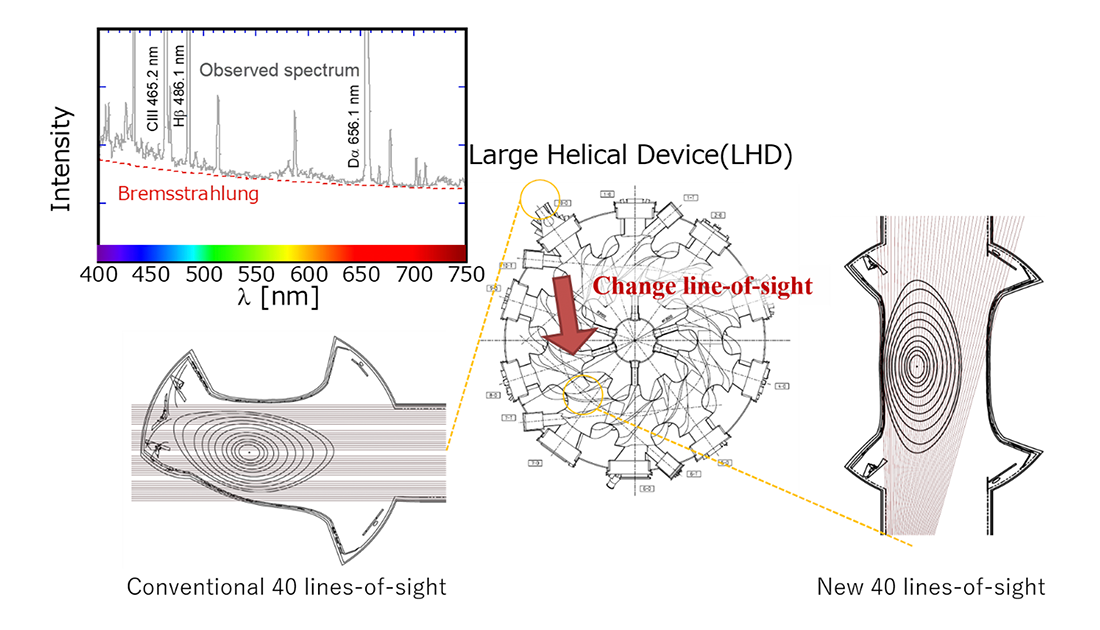Improved measurement of the effective ion charge represented the amount of impurities in the plasma
We have improved the measurement of the effective ion charge (Zeff), which represents the amount of impurities in the plasma in LHD. In previous measurements, Zeff was evaluated using signal obtained by the visible spectrometer for a long horizontal plasma cross-section, but an overestimated value was calculated due to the effect of light in scrape of layer which is around the plasma. In order to avoid this effect, the measurement line-of-sight was changed to a plasma cross section with a long vertical direction, which led to an improvement in the Zeff evaluation.

We have improved the measurement of the effective ion charge (Zeff), which represents the amount of impurities in the plasma in the Large Helical Device (LHD). In previous measurements, Zeff was evaluated using a signal obtained by the visible spectrometer for a long horizontal plasma cross-section, but an overestimated value was calculated due to the effect of light in the Scrape-Off Layer which is around the plasma. In order to avoid this effect, the measurement line-of-sight was changed to a plasma cross section with a long vertical direction, which led to an improvement in the Zeff evaluation.
The Zeff, a physical quantity used to evaluate the amount of impurities in plasma, is evaluated using bremsstrahlung emissivity, which increases with the charge number and density of nuclei in the plasma. In general, visible bremsstrahlung intensity is employed for Zeff evaluation because it is not affected by electron temperature and is easy to measure. However, the measured bremsstrahlung intensity contains various emissions other than the bremsstrahlung to be evaluated (e.g., emissions from the surrounding plasma called the ergodic layer and reflections from the wall), which results in an overestimation. Therefore, by installing the visible spectrometer at a port that can measure "vertically long plasmas", which has a thin ergodic layer and little reflection from the wall, we have been able to reduce the influence from the surrounding plasma and improve the Zeff evaluation.
In conventional bremsstrahlung measurements, a visible spectrometer with 40 horizontal lines-of-sight is used for long horizontal plasmas. Bremsstrahlung emissivity is roughly proportional to the square of the electron density, however, the intensity of bremsstrahlung measured with this spectrometer far exceeds the expected. In the case of inner-parallel plasmas (magnetic axis Rax = 3.6 m), which is often the case in LHD experiments, the evaluated value especially in the upper half, is sometimes overestimated. This is unrealistic in LHD plasmas. We suspected that the complex structure of the magnetic field and opposing wall structures along with measurement line-of-sight caused non-uniform bremsstrahlung emission, impurity lines, and reflections from the walls, so that the correct Zeff was not being evaluated.
Therefore, by changing the measurement port to a longitudinal cross section with the measurement lines-of-sight through a relatively simple structure, the non-uniform bremsstrahlung disappeared from the signal and the observed bremsstrahlung profile was found to be almost symmetric between the inside and outside of the donut. The symmetrical distribution of Zeff experimentally suggests that the impurity in the core plasma may be uniform with respect to the magnetic plane. This is expected to lead to a local evaluation of Zeff, which has been difficult to calculate from the asymmetric bremsstrahlung profile.
Zeff is an important physical quantity for fusion plasma research, which is also used as an indicator of plasma performance and for plasma transport analysis. Although it is still difficult to evaluate Zeff accurately in the measurement lines-of-sight where the ergodic layer is thick and in plasmas with low electron density, we will continue to analyze the causes of Zeff overestimation and to achieve sufficient accuracy even in low-density plasmas.
This research result was published on July 7, 2021 in Plasma and Fusion Research, an online journal by the Japan Society of Plasma Science and Nuclear Fusion Research.
